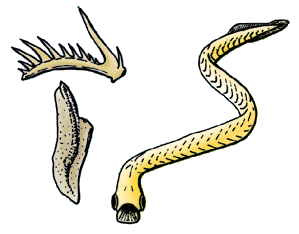
Conodonts are extinct agnathan chordates resembling eels, classified in the class Conodonta. For many years, they were known only from tooth-like microfossils found in isolation and now called conodont elements. Knowledge about soft tissues remains limited. The animals are also called Conodontophora to avoid ambiguity.
The Bashkirian is in the ICS geologic timescale the lowest stage or oldest age of the Pennsylvanian. The Bashkirian age lasted from 323.2 to 315.2 Ma, is preceded by the Serpukhovian and is followed by the Moscovian.
The Tournaisian is in the ICS geologic timescale the lowest stage or oldest age of the Mississippian, the oldest subsystem of the Carboniferous. The Tournaisian age lasted from 358.9 Ma to 346.7 Ma. It is preceded by the Famennian and is followed by the Viséan.
The Visean, Viséan or Visian is an age in the ICS geologic timescale or a stage in the stratigraphic column. It is the second stage of the Mississippian, the lower subsystem of the Carboniferous. The Visean lasted from 346.7 to 330.9 Ma. It follows the Tournaisian age/stage and is followed by the Serpukhovian age/stage.
The Serpukhovian is in the ICS geologic timescale the uppermost stage or youngest age of the Mississippian, the lower subsystem of the Carboniferous. The Serpukhovian age lasted from 330.9 Ma to 323.2 Ma. It is preceded by the Visean and is followed by the Bashkirian.
The Kasimovian is a geochronologic age or chronostratigraphic stage in the ICS geologic timescale. It is the third stage in the Pennsylvanian, lasting from 307 to 303.7 Ma. The Kasimovian stage follows the Moscovian and is followed by the Gzhelian. The Kasimovian saw an extinction event which occurred around 305 mya, referred to as the Carboniferous Rainforest Collapse.
Hindeodus is an extinct genus of conodonts in the family Anchignathodontidae. The generic name Hindeodus is a tribute to George Jennings Hinde.
Paleontology or palaeontology is the study of prehistoric life forms on Earth through the examination of plant and animal fossils. This includes the study of body fossils, tracks (ichnites), burrows, cast-off parts, fossilised feces (coprolites), palynomorphs and chemical residues. Because humans have encountered fossils for millennia, paleontology has a long history both before and after becoming formalized as a science. This article records significant discoveries and events related to paleontology that occurred or were published in the year 1975.
Proconodontida is an order of conodonts.
Diplognathodus is an extinct genus of conodonts in the family Anchignathodontidae. Specimens are found in Carboniferous and Permian formations.
Clarkina is an extinct genus of conodonts. It is considered to be an offshore, outer shelf or basinal, deep-water taxon.
Neogondolellla is an extinct genus of conodonts. Neogondolela regalis was re-evaluated in 2018 by Martyn Lee Golding.
Heinz Walter Kozur was a German paleontologist and stratigrapher.
Chiosella is an extinct conodont genus.
Carnepigondolella is an extinct genus of conodonts of the Late Triassic of Italy or Canada.
Vjalovognathus is an extinct genus of conodonts.
Misikella is an extinct genus of conodonts. It is a genus with a tetramembrate conodont apparatus.
The Alaunian, also known as "Middle Norian", is a sub-age in the Upper Triassic. It is followed by the Upper Norian, also known as Sevatian.
Neohindeodella is an extinct genus of conodonts. Neohindeodella detrei, a species of Neohindeodella, has the distinction of being the very last species of conodonts to finally become extinct, during the Hettangian stage of the early Lower Jurassic Period.



